11 Home Remedies To Get Rid Of Rashes Under The Breast
Find out what causes rashes down there and how to get long-term relief.
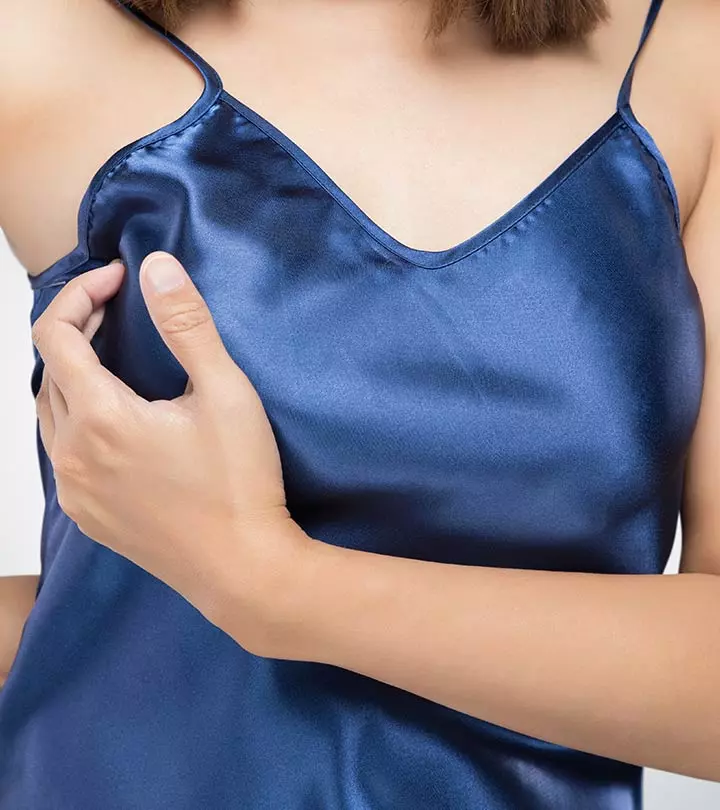
Image: Shutterstock
If you are here wondering how to get rid of rashes under the breast, we got you covered. A rash under the breast might flare up at any time and is triggered mostly due to seasonal allergies, excess humidity, and tight-fitting clothing. We have listed a few natural remedies that can provide you some initial relief from the itch and irritation to save you from the embarrassment and deal with them. Read on further to know more.

In This Article
Causes And Symptoms Of Rashes Under The Breast
If you notice irritation or redness of the skin under your breasts, you have most probably developed a breast rash. Several factors can cause rashes under your breasts. While one of the most common causes is a heat rash, other triggers can be classified into four categories. They are:
- Infections
The skin folds under your breasts as well as other body parts are the ideal breeding ground for yeast, fungal, and bacterial infection. Candidiasis, which is caused by a type of yeast called Candida, and ringworm, which is a fungal infection caused by a fungus called dermatophytes, can both result in rashes under the breasts.
Itchy blisters, cracks, and red, round patches of skin that look like a ring are some of the common signs associated with such infections.
- Allergies
If you have developed red or skin-colored bumps under your breasts that itch a lot, it could be hives. Hives are formed as a result of an allergic response of your body to certain foods, medications, pollen, plants, and insect bites. Hives will usually blanch and turn white when pressed.
- Autoimmune Disorders
Autoimmune conditions like eczema, inverse psoriasis, hyperhidrosis, and Hailey-Hailey disease can also cause rashes to form on different parts of your body, including the folds under your breasts.
Eczema is characterized by small, fluid-filled blisters that eventually ooze and crust over. The symptoms of inverse psoriasis include smoothened, red patches of skin in the affected area.
Hyperhidrosis causes frequent sweating that leads to the formation of rashes. Hailey-Hailey disease triggers blistering rashes in the affected body parts.
Since allergies and disorders like eczema are common in the US, these are some of the most common causes of rashes under the breast. As per the data from CDC, about one quarter (25.7%) of adults have a seasonal allergy and 7.3% have eczema. About 1 in 3 U.S. adults have reported an allergy or eczema in their lifetime.
- Cancer
Another cause of rashes under your breasts could be inflammatory breast cancer, which is a rare but rapidly spreading type of cancer. Its symptoms may include:
- Pink or red discoloration of the skin
- Pitted skin that may resemble an orange peel
- A pimple-like rash
- An inverted nipple that points inward rather than outward
- Shingles
Another cause of rashes under the breast may be shingles. It is caused by the varicella-zoster virus that leads to a painful rash. When it occurs under the breast, it can be especially uncomfortable due to the sensitivity of the skin in that area. The rash typically starts as a burning or tingling sensation and then progresses to clusters of fluid-filled blisters. It’s essential to seek medical attention immediately, as antiviral medications help alleviate symptoms and reduce the risk of complications. Keeping the affected area clean and dry and avoiding tight clothing may also provide some relief. Pain management techniques may be necessary to manage discomfort. In most cases resolve within a few weeks, but some individuals may experience lingering pain, known as postherpetic neuralgia.
Jessie, a blogger, shared her experience about getting rashes under her breast in her personal blog. She said, “I get horrific heat rash between and below my breasts. When we moved into this house I wore an underwire bra during the move and it rubbed me raw under my boobs. It smelled like meat and was so painful (i)!”
The causes of rashes under the breast may vary in their gravity. While such rashes are hardly a cause of concern most of the time, they may also be a result of life-threatening diseases like cancer.
If your symptoms are similar to that of any serious medical conditions, it is best to avail medical intervention immediately to rule out any complications.
Key Takeaways
- Rashes under your breasts may happen due to seasonal allergies and excessive sweating.
- Treating these rashes includes home remedies like baking soda, coconut oil, aloe vera, and neem leaves.
- Keep your skin clean and dry and fragrance-free skincare products.
- To prevent rashes from recurring, try to wear soft clothing and absorb excess sweat with bra liners.
How Is A Rash Under The Breast Treated?
The cause of the rash under your breasts will determine how you treat it. Consult a healthcare provider immediately if the rash remains for more than a week or the home remedies do not provide relief or symptoms worsen. A specialist can assist in determining the root causes and suggest suitable remedies, including prescription drugs or additional diagnostic tests.
- Common Rashes On The Skin
Avoiding skin irritants is one of the best ways to prevent common rashes. This can include avoiding certain soaps or cosmetics that you are allergic or sensitive to avoid chafing, as this may cause soreness under the breast. You can use remedies for chafing to fight the irritation. You may want to identify and avoid wearing bras or tops made of specific fabrics. The doctor might prescribe medication or a topical cream to reduce the rash. In most situations, the rash is resolved or controlled without posing a significant risk to your general health.
Dermatitis or eczema is pretty common in breastfeeding women. Other common rashes in breastfeeding women also include folliculitis, abscess and sebaceous cyst. Speaking with a doctor or lactation consultant is advised in these situations because breastfeeding individuals may require different treatment. Dr. Anna Chacon, MD, FAAD, a double-board-certified dermatologist, says, “The remaining moisture on the breast, which can irritate the skin and result in dermatitis, is a typical cause of nursing rashes.” You can use breast pads to prevent these rashes. She adds, “Breast pads prevent moisture from evaporating from the skin and absorb any excess milk that may remain after feeding.”
- Inflammatory Breast Cancer
The diagnosis of inflammatory breast cancer is given after careful examination and tissue biopsyi A medical procedure in which a surgeon collects a sample of cells or tissues from the body to examine the presence of a disease. . This stage is quite advanced and needs to be treated right away. Surgery, radiation, chemotherapyi A type of cancer treatment that uses drugs to inhibit the growth of malignant cells by preventing them from dividing further. radiation, and hormone therapyi A type of cancer treatment that slows or prevents cancer that relies on hormones to spread or grow, such as prostate and breast cancer. radiation are all possible forms of treatment, usually starting with chemotherapy radiation (1).
If the rash under your breasts is due to microbial infections or allergies, here are some home remedies that may help you treat it.
11 Natural Remedies To Get Rid Of Rashes Under The Breast
For those suffering from rash under the breasts, these remedies might provide relief. However, keep in mind that results can vary depending on your skin type and severity.
1. Baking Soda
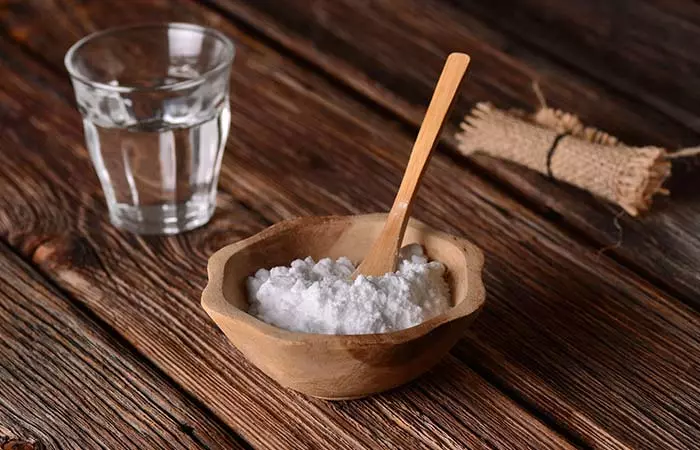
The alkalinity of baking soda increases the pH of your skin and helps relieve itchiness associated with rashes under your breasts. It can also help in the removal of scales from the skin if any (2).
You Will Need
- 1 teaspoon of baking soda
- A few drops of water
What You Have To Do
- Add a few drops of water to a teaspoon of baking soda.
- Mix well and apply the mixture to the affected areas.
- Leave it on for 20-30 minutes.
- Rinse it off with water.
How Often You Should Do This
You may do this once daily.
2. Coconut Oil
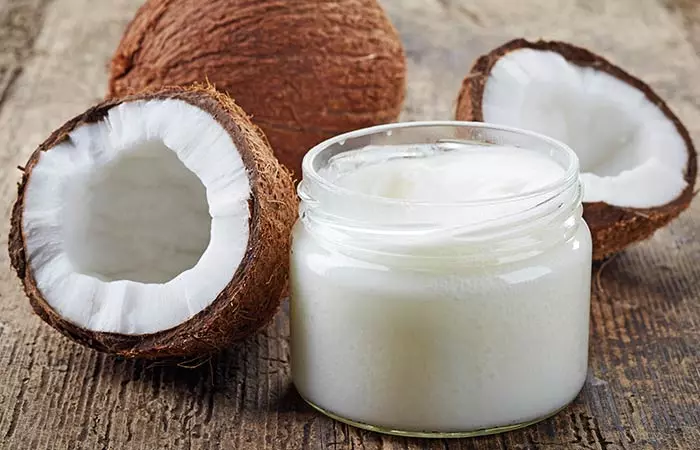
The anti-inflammatory and analgesic activities of coconut oil can help in getting rid of rashes under the breasts (3). Studies show that monolaurin, a natural compound found in coconut oil, can help against infections. The antimicrobial potential of coconut oil against Candida can be used to treat yeast infections that could be causing rashes (4).
You Will Need
- 1-2 teaspoons of virgin coconut oil
What You Have To Do
- Rub virgin coconut oil in your palms and apply it over the affected area.
- Leave it on until it dries.
How Often You Should Do This
You may do this 1-2 times daily.
3. Tea Tree Essential Oil
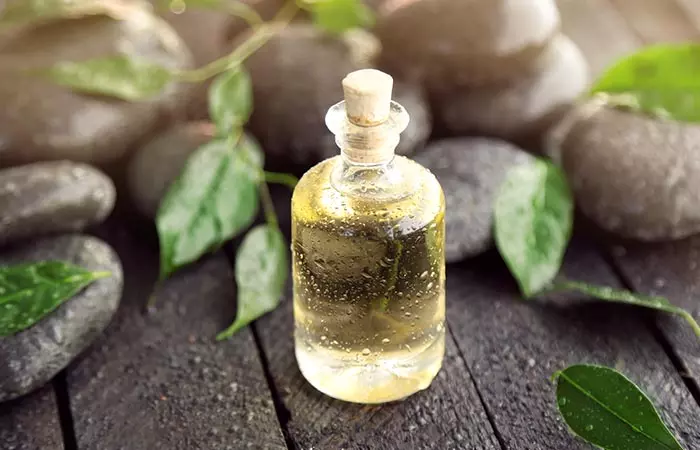
Tea tree oil exhibits antimicrobial and anti-inflammatory properties (5). These properties can help in getting rid of rashes under the breast by eliminating the infection-causing microbes and reducing swelling and itching.
You Will Need
- 2-3 drops of tea tree oil
- 2-3 teaspoons of any carrier oil (coconut or olive oil)
What You Have To Do
- Add two to three drops of tea tree oil to two to three teaspoons of any carrier oil.
- Mix well and apply to the affected area.
- Leave it on overnight.
- Rinse it off the next morning.
How Often You Should Do This
You can do this once daily.
4. Apple Cider Vinegar

Apple cider vinegar exhibits antimicrobial properties that work effectively against multiple microbes, including Candida. Hence, this remedy may be useful if the rashes under your breasts are the result of a yeast infection (6).
You Will Need
- 1-2 tablespoons of organic apple cider vinegar
- ½ cup of water
- Cotton balls
What You Have To Do
- Add one to two tablespoons of raw apple cider vinegar to half a cup of water.
- Mix well and soak a cotton ball in it.
- Apply the mixture to the affected area and allow it to dry.
- Rinse it off with water.
How Often You Should Do This
You can do this multiple times daily.
5. Cold Compress
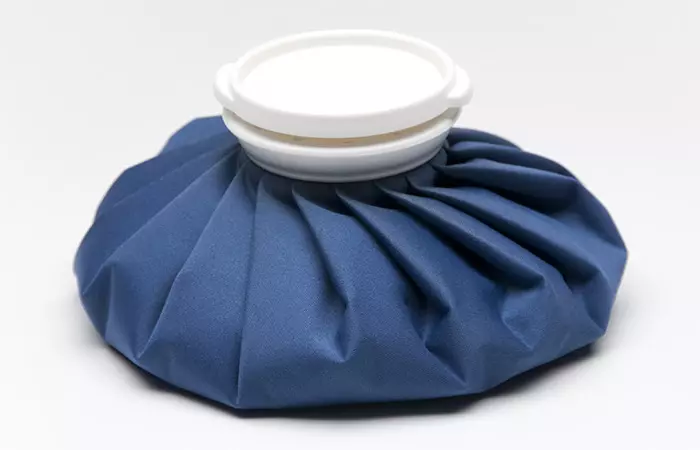
A cold compress numbs the affected area, thereby helping in reducing the itchiness that often occurs in the case of rashes under the breast (7).
You Will Need
- A cold compress
What You Have To Do
- Apply a cold compress to the affected area.
- Leave it on for 5-10 minutes and remove it.
- Repeat twice.
How Often You Should Do This
You may do this multiple times daily.
6. Garlic
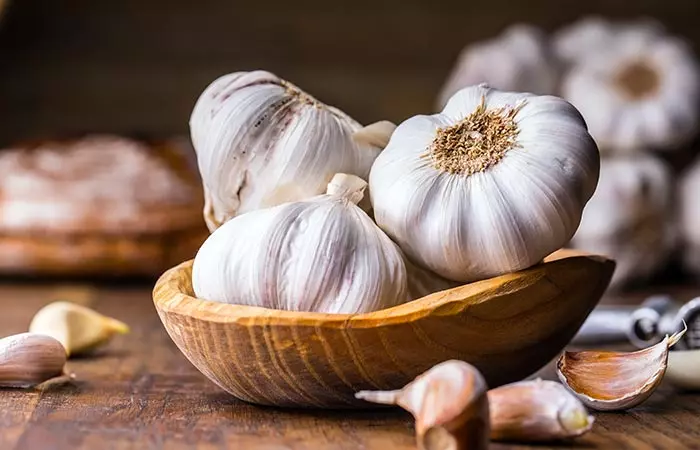
Garlic offers multiple benefits for your skin. It has both anti-inflammatory and antimicrobial properties, which can help in treating skin infections that cause rashes under the breasts (8), (9).
You Will Need
- 1-2 garlic cloves
- 1 tablespoon of olive oil
What You Have To Do
- Mince the garlic cloves.
- Add a tablespoon of olive oil to the minced garlic and heat it slightly.
- Strain the garlic cloves out.
- Apply the oil to the affected area.
- Leave it on overnight.
- Rinse it off the next morning.
How Often You Should Do This
You may do this once daily.
 Quick Tip
Quick Tip7. Aloe Vera
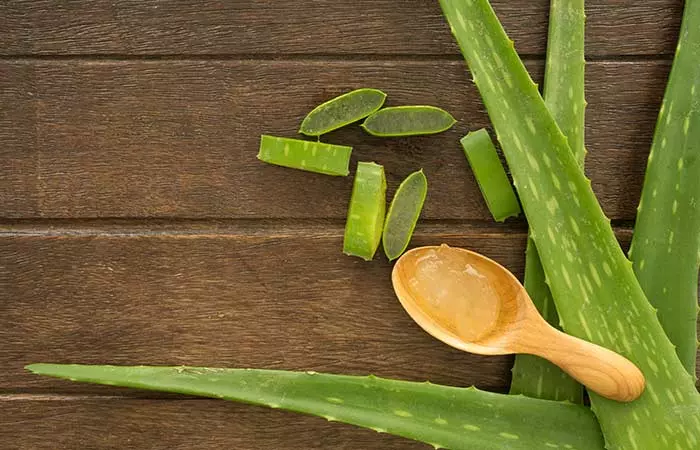
The anti-inflammatory activity of aloe vera extracts can be used in soothing the itchiness and inflammation associated with rashes under the breast. The study published in National Library of Medicine shows that aloe vera gel extracts can reduce inflammation. This happens because they stop the body from making certain chemicals, called indomethacin and dexamethasone, that cause swelling and redness (10). It is also very effective for armpit rash.
You Will Need
- Freshly extracted aloe vera gel
What You Have To Do
- Extract the gel from an aloe leaf.
- Whisk the gel using a fork and apply it to the affected area.
- Leave it on for 20-30 minutes and then rinse it off with water.
How Often You Should Do This
You may do this 1-2 times daily.
8. Neem
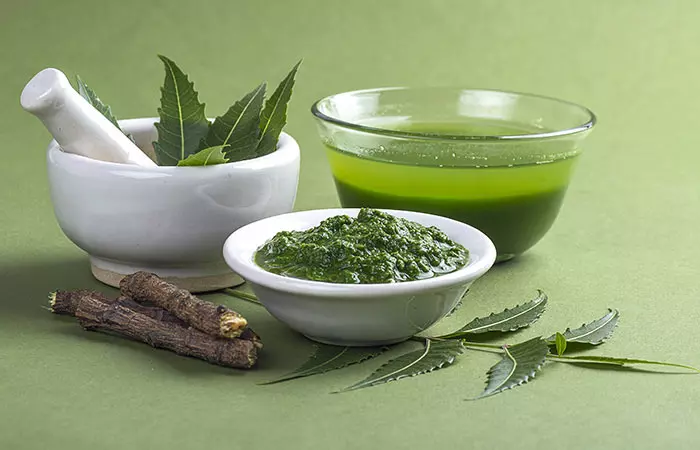
Neem exhibits many therapeutic benefits, including its ability to reduce inflammation and fight infections (11). These properties can also help reduce breast rashes and prevent their recurrence.
You Will Need
- A handful of neem leaves
- Water (as required)
What You Have To Do
- Wash the neem leaves thoroughly.
- Grind the leaves with a little water to form a thick paste.
- Apply the neem paste to the affected skin and leave it on for 20-30 minutes.
- Rinse it off with water.
How Often You Should Do This
You may do this once daily.
9. Oatmeal
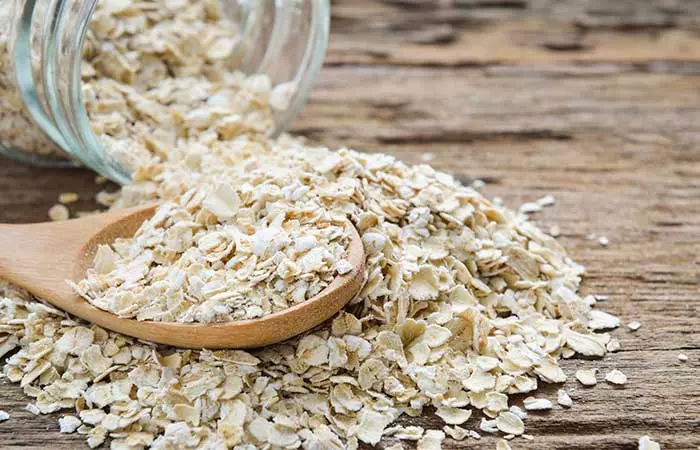
Oatmeal has anti-inflammatory and antioxidant properties that may be used in the treatment of rashes under the breasts (12).
You Will Need
- 1 cup of ground oats
- Water
What You Have To Do
- Fill your bath with water.
- Add a cup of ground oats to it and mix well.
- Soak in the oatmeal bath for 20-30 minutes.
How Often You Should Do This
You may do this once daily.
10. Witch Hazel
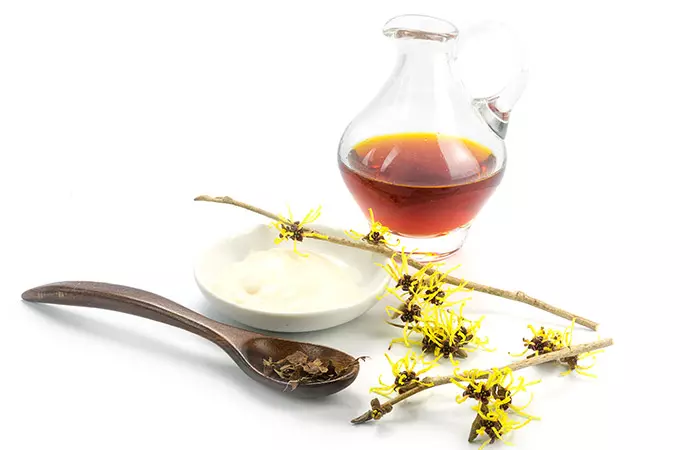
The antioxidant and anti-inflammatory potential of witch hazel can help in the treatment of rashes under the breasts and alleviate itching and inflammation (13).
You Will Need
- Witch hazel (as required)
- Cotton balls
What You Have To Do
- Take some witch hazel on a cotton ball and apply it to the affected area.
- Allow it to dry on its own.
How Often You Should Do This
You may do this 1-2 times daily.
11. Turmeric
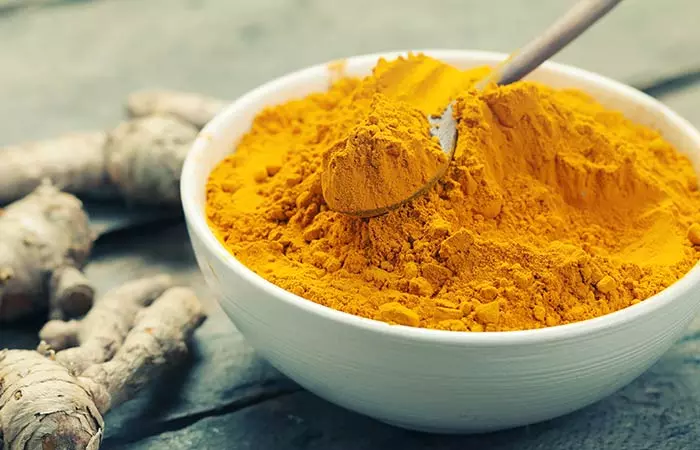
The major component of turmeric is curcumin. This compound has antioxidant and anti-inflammatory properties, which can help in treating the rashes under the breasts (14).
You Will Need
- 1-2 teaspoons of turmeric powder
- Water (as required)
What You Have To Do
- Mix 1-2 teaspoons of turmeric powder with a few drops of water.
- Mix well to form a thick paste.
- Apply the paste to the affected area and leave it on for 15-20 minutes.
- Rinse it off with water.
How Often You Should Do This
You may do this once daily or every alternate day.
These remedies may work differently for each person, depending on skin type, the cause of the rash, and its severity. What works for one individual may not be effective for another. If the condition worsens or doesn’t improve, or if the rash is severe, it is important to seek medical advice. Always perform a patch test before trying new remedies to avoid potential allergic reactions.
While you allow these remedies to work on those stubborn rashes under your breasts, here are some beneficial tips that can prevent the rashes from recurring.
How To Prevent Rashes Under The Breast
- Clean the affected area with antibacterial soap and water daily.
- Use only fragrance-free moisturizers.
- Avoid scratching the affected area.
- Wear soft clothing that does not irritate your skin.
- Change out of sweaty clothing right away.
- Limit wearing your bra as much as possible until the rash begins clearing.
- Wear bra liners to absorb excess sweat.
- Apply Calamine lotion on the affected area.
- Choose well-fitted bras made of moisture-wicking materials to reduce sweat buildup.
- Apply talcum powder or anti-chafing creams to reduce friction.
- Steer clear of harsh soaps, perfumes, or detergents that may cause irritation.
- Manage any fungal infections or skin sensitivities with appropriate treatments.
 Quick Tip
Quick TipIf the rash does not disappear after using OTC medications and home remedies, you should consult a doctor to determine the root cause of the rash.
When Should You See A Doctor?
If you have a skin rash along with any of the following symptoms, consult a doctor right away:
- The rash is rapidly spreading all over your body.
- Your skin is thick, warm, and red.
- You are exhausted, shivering, nauseous, or vomiting
- You have a fever.
- You have discolored, bleeding, peeling, or blistered skin.
- There are uneven, multicolored, dark dots.
- The patches or rash morph in size and shape.
Remember that self-diagnosis of a breast rash can be challenging. In some situations, a delay in treatment may mean the difference between a favorable outcome and a more severe health problem.
Infographic: 3 Lesser-Known Causes Of Rashes Under The Breast And How They Are Treated
The treatment for a rash under the breasts depends on the cause of the condition, and the causes, in this case, can be varied. Check out the infographic to learn about some of the less common causes of rashes under the breast.
Some thing wrong with infographic shortcode. please verify shortcode syntax
The Final Takeaway
Rash under breasts may be completely benign or signify serious complications and medical conditions. However, it is caused due to seasonal allergies, infections, excess humidity, or tight-fitting clothing in most cases. To get rid of the discomfort and itching sensation, you can apply home remedies made from common ingredients like baking soda, coconut oil, tea tree essential oil, aloe vera, apple cider vinegar, and neem leaves, among others. If the rash persists, looks infected, or recurs frequently, get in touch with your healthcare provider for a diagnosis and line of treatment.
Frequently Asked Questions
Does a yeast infection under the breast smell?
Yes, if left untreated, yeast infections under the breasts can give off a foul odor.
Can I use deodorant under my breasts?
Yes, you can use a deodorant or antiperspiranti An astringent solution that contains zirconium or aluminum used to reduce sweating and avoid body odor. under your breasts. However, this is not recommended if you are breastfeeding.
How long should a breast rash last?
A breast rash should ideally disappear in a few days or weeks. However, if it doesn’t, it is best to see a doctor immediately.
How do I stop sweating between my breasts?
You can stop excessive sweating between your breasts by using any deodorizing talc and wearing soft and breathable clothing. Sweat or moisture-wicking bras are also available to tackle this problem.
Will going braless affect your breast health?
There is no scientific proof that suggests that going braless will affect your breast health in any way. It may, however, cause your breasts to sag in the long run.
What doctor to visit for rashes under the breasts?
You can visit a dermatologist for rashes under the breasts. Depending on your symptoms, your dermatologist may either prescribe the required treatment or refer you to another specialist.
What causes clogged pores under breasts?
Just the way the pores on your face can get clogged with oil, debris, bacteria, sweat, or dead skin cells, so can the pores on your breasts. Some people are more prone to clogged pores and breast acne breakouts due to several factors. These include:
• Stress
• Diet
• Hormonal changes
• Genetics
• Certain medications
• Poor hygiene
• Tight-fitting clothes
• Certain creams or lotions
Can cornstarch be used to treat rashes under the breasts?
While no studies support the idea that cornstarch can be used to treat rashes under the breasts, it is claimed that it is especially effective in reducing the burning and itching associated with a heat or sweat rash.
Start by cleansing the affected area with a gentle soap and water if you wish to try out this treatment for your breast rash. Then, wipe away any remaining moisture with a soft towel. Finally, apply cornstarch to the affected area when the skin has completely dried.
What does a breast yeast rash look like?
Yeast infection under the breast looks like a raised, shiny bright red rash under the warm moist folds of the skin. It also may have blisters or crusting.
Can sweat cause a rash under the breasts?
Yes. Also called heat rashes, these occur when excess sweat is produced by sweat glands, which, then, gets blocked from reaching up to the skin surface. This is common during hot and humid weather.
Can a dirty bra cause a rash under the breast?
A sweaty bra, if worn for long (especially after a workout), can cause rashes under the skin as the build-up of sweat and oil may cause fungal infections.
Illustration: Home Remedies To Get Rid Of Rashes Under The Breast
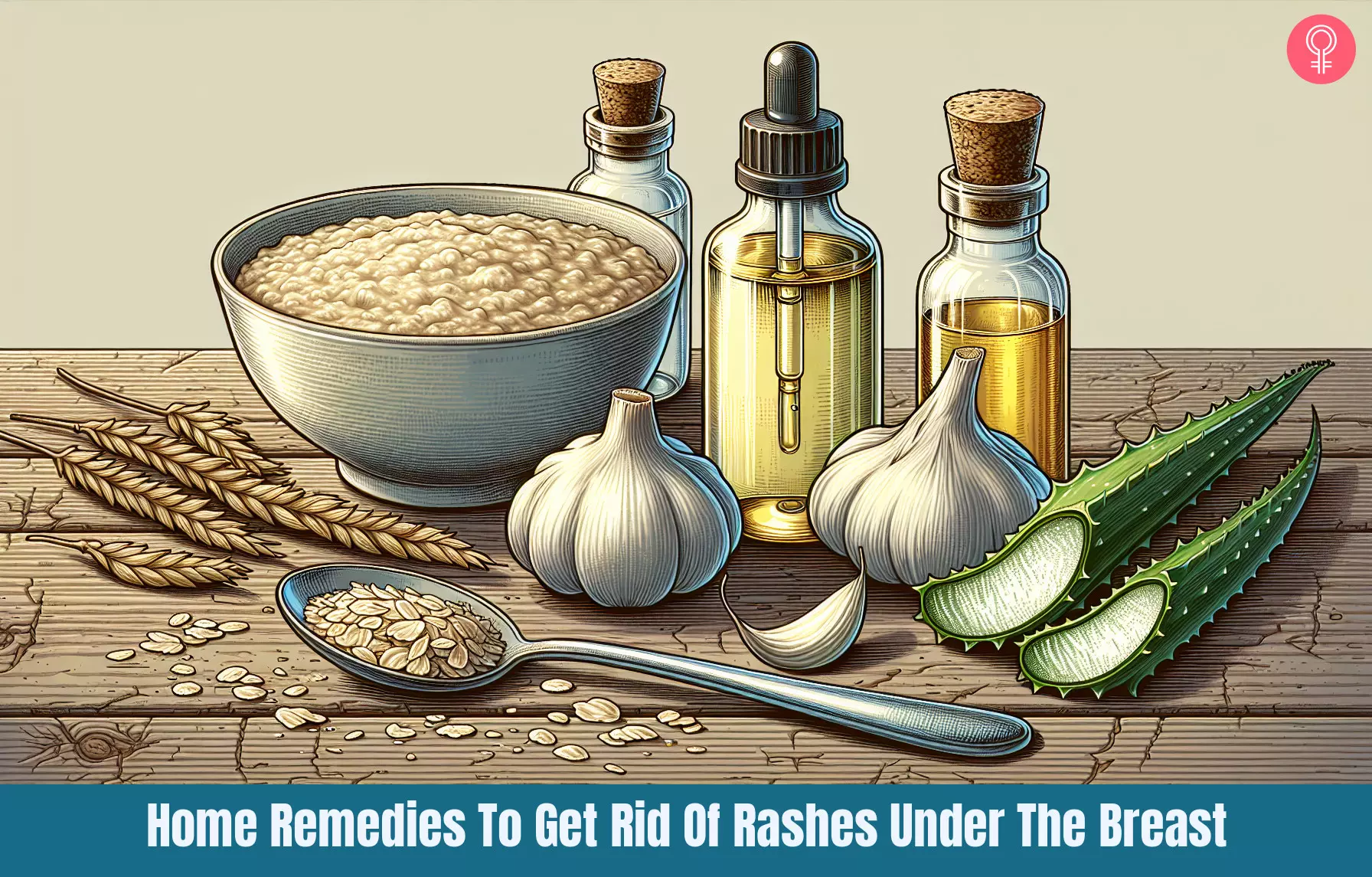
Image: Dall·E/StyleCraze Design Team
Discover ten natural remedies to tackle the discomfort of a rash under the breast in this helpful video. Learn effective techniques and find relief using safe, accessible ingredients by checking out the video below.
Personal Experience: Source
StyleCraze's articles are interwoven with authentic personal narratives that provide depth and resonance to our content. Below are the sources of the personal accounts referenced in this article.
i. On Transitions or “Good-bye Big Boobs!”https://roseandwry.wordpress.com/2018/11/27/on-transitions-or-good-bye-big-boobs/
References
Articles on StyleCraze are backed by verified information from peer-reviewed and academic research papers, reputed organizations, research institutions, and medical associations to ensure accuracy and relevance. Read our editorial policy to learn more.
- Inflammatory Breast Cancer: What We Know and What We Need to Learn
https://www.ncbi.nlm.nih.gov/pmc/articles/PMC3399643/ - Scaly skin and bath pH: Rediscovering baking soda, Journal Of The American Academy Of Dermatology.
https://www.jaad.org/article/S0190-9622(09)00493-9/fulltext - Anti-inflammatory, analgesic, and antipyretic activities of virgin coconut oil. Pharmaceutical Biology, US National Library Of Medicine, National Institutes of Health.
https://pubmed.ncbi.nlm.nih.gov/20645831// - In vitro evaluation of the antifungal activity of monolaurin against Candida albicans biofilms. PeerJ, US National Library Of Medicine, National Institutes of Health.
https://pubmed.ncbi.nlm.nih.gov/27366648/ - Melaleuca alternifolia (Tea Tree) Oil: a Review of Antimicrobial and Other Medicinal Properties, Clinical Microbiology Reviews, US National Library Of Medicine, National Institutes of Health.
https://www.ncbi.nlm.nih.gov/pmc/articles/PMC1360273/ - Antimicrobial activity of apple cider vinegar against Escherichia coli, Staphylococcus aureus and Candida albicans; downregulating cytokine and microbial protein expression, Scientific Reports, US National Library Of Medicine, National Institutes of Health.
https://www.ncbi.nlm.nih.gov/pmc/articles/PMC5788933/ - Effects of menthol and cold on histamine-induced itch and skin reactions in man. Neuroscience Letters, US National Library Of Medicine, National Institutes of Health.
https://www.ncbi.nlm.nih.gov/pmc/articles/PMC6301073/ - [Ajoene the main active compound of garlic (Allium sativum): a new antifungal agent]. Ibero-American Journal of Mycology, US National Library Of Medicine, National Institutes of Health.
https://pubmed.ncbi.nlm.nih.gov/16854181/ - Anti-Wrinkle and Anti-Inflammatory Effects of Active Garlic Components and the Inhibition of MMPs via NF-κB Signaling, PLoS ONE, US National Library Of Medicine, National Institutes of Health.
https://www.ncbi.nlm.nih.gov/pmc/articles/PMC3774756/ - Anti-inflammatory activity of extracts from Aloe vera gel. Journal Of Ethnopharmacology, US National Library Of Medicine, National Institutes of Health.
https://pubmed.ncbi.nlm.nih.gov/9121170/ - Therapeutics Role of Azadirachta indica (Neem) and Their Active Constituents in Diseases Prevention and Treatment, Evidence-based Complementary And Alternative Medicine, US National Library Of Medicine, National Institutes of Health.
https://www.ncbi.nlm.nih.gov/pmc/articles/PMC4791507/ - Anti-inflammatory activities of colloidal oatmeal (Avena sativa) contribute to the effectiveness of oats in the treatment of itch associated with dry, irritated skin. Journal of Drugs in Dermatology, US National Library Of Medicine, National Institutes of Health.
https://pubmed.ncbi.nlm.nih.gov/25607907/ - Antioxidant and potential anti-inflammatory activity of extracts and formulations of white tea rose, and witch hazel on primary human dermal fibroblast cells, Journal Of Inflammation, US National Library Of Medicine, National Institutes of Health.
https://www.ncbi.nlm.nih.gov/pmc/articles/PMC3214789/ - Antioxidant and anti-inflammatory properties of curcumin. Advances in Experimental Medicine and Biology, US National Library Of Medicine, National Institutes of Health.
https://pubmed.ncbi.nlm.nih.gov/17569207/
Read full bio of Dr. Jennifer Mercier
- Dr. Anna Chacon, MD, FAAD, is a double board-certified dermatologist with over 7 years of experience. She has authored many peer-reviewed articles and managed clinical research studies during her fellowship. She completed her medical school in the PLME (Program of Liberal Medical Education) at Brown University.
 Dr. Anna Chacon, MD, FAAD, is a double board-certified dermatologist with over 7 years of experience. She has authored many peer-reviewed articles and managed clinical research studies during her fellowship. She completed her medical school in the PLME (Program of Liberal Medical Education) at Brown University.
Dr. Anna Chacon, MD, FAAD, is a double board-certified dermatologist with over 7 years of experience. She has authored many peer-reviewed articles and managed clinical research studies during her fellowship. She completed her medical school in the PLME (Program of Liberal Medical Education) at Brown University.
Read full bio of Monomita Chakraborty
Read full bio of Anjali Sayee
Read full bio of Swathi E







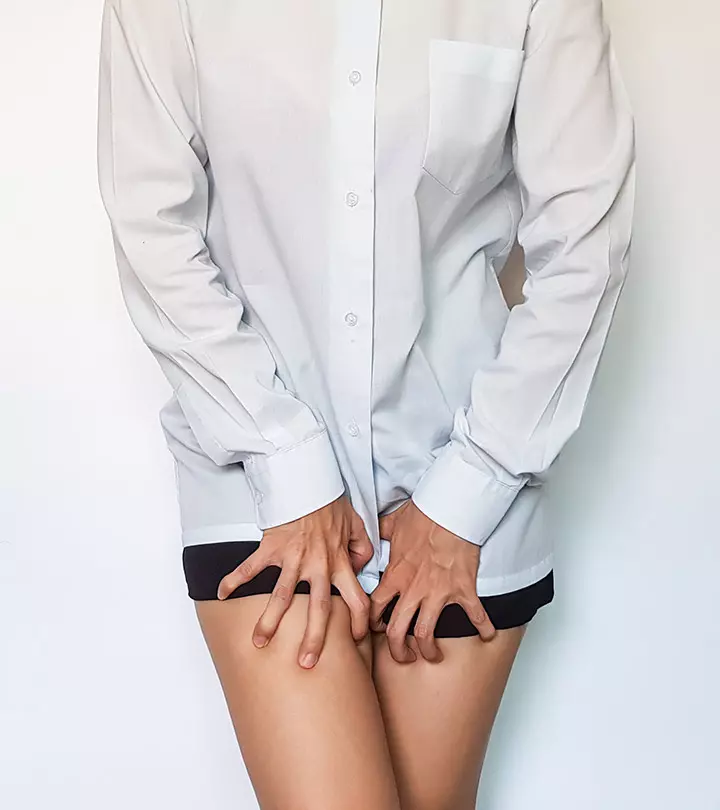
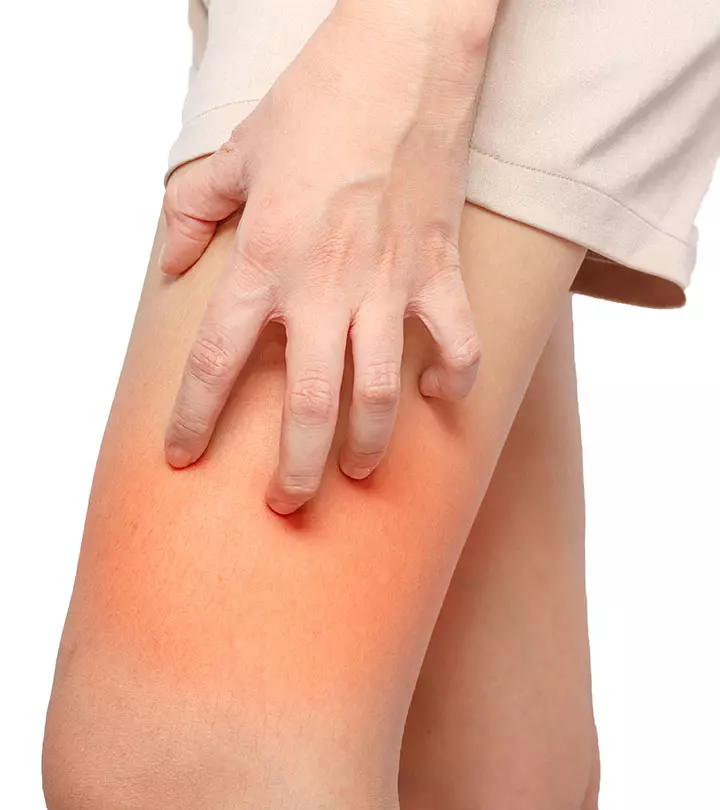
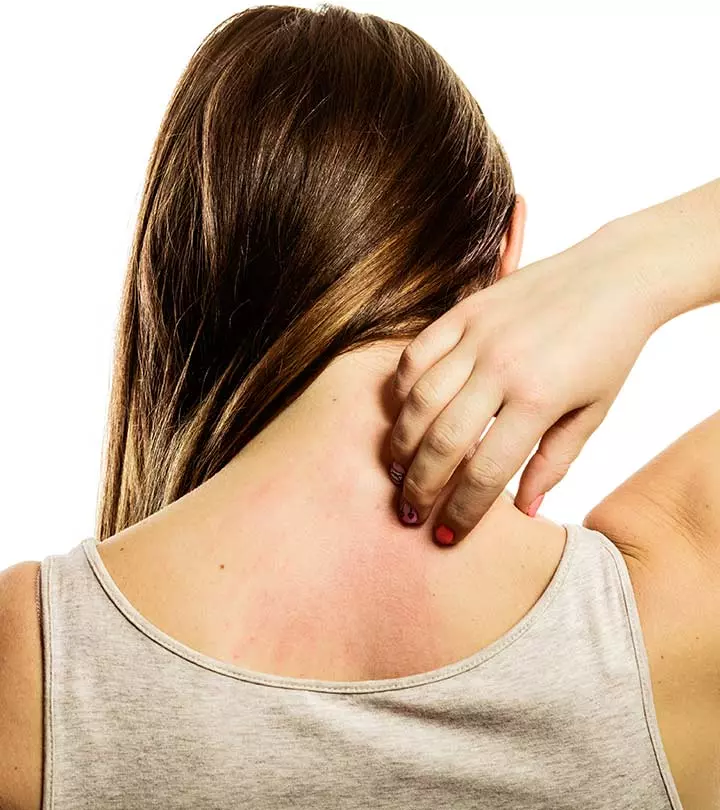
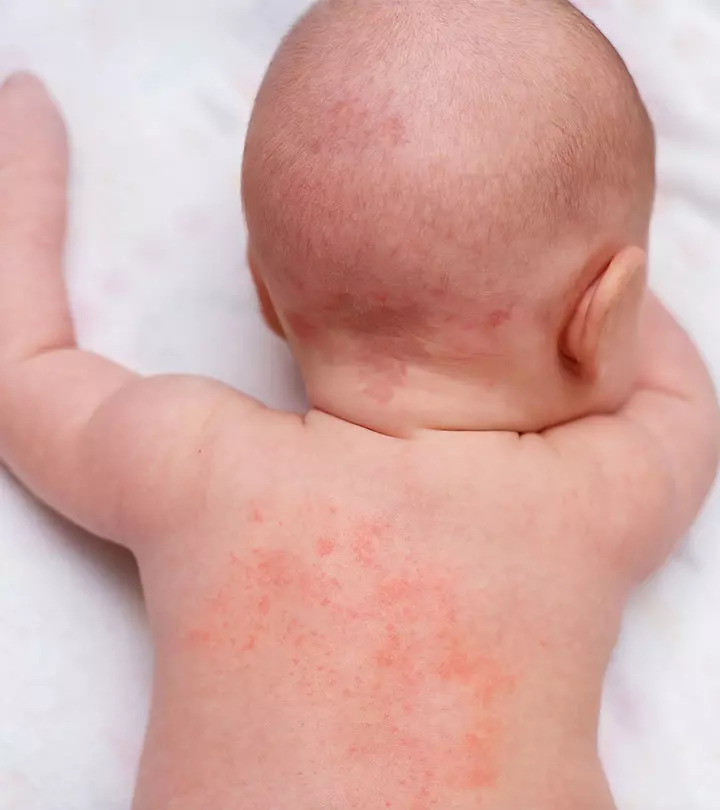
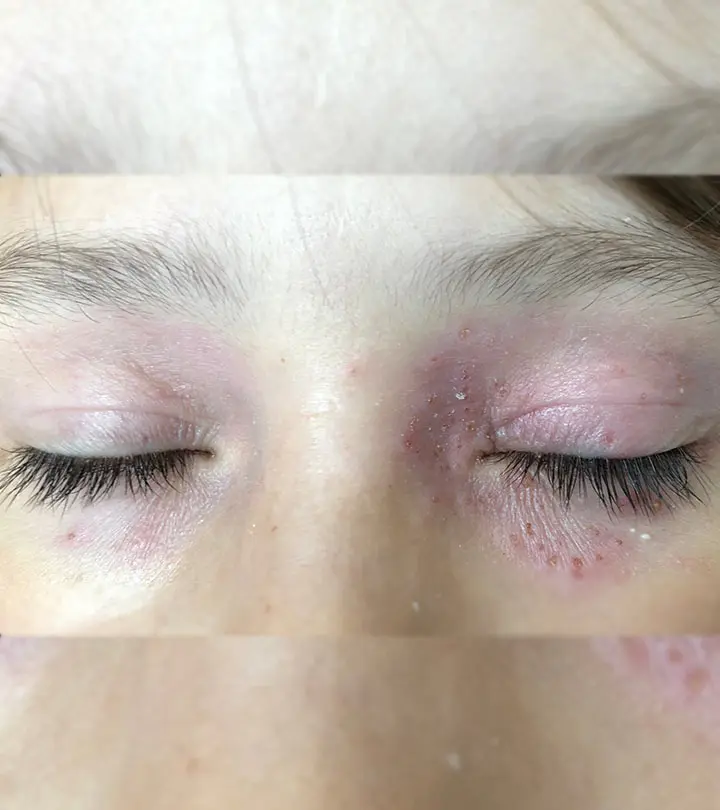
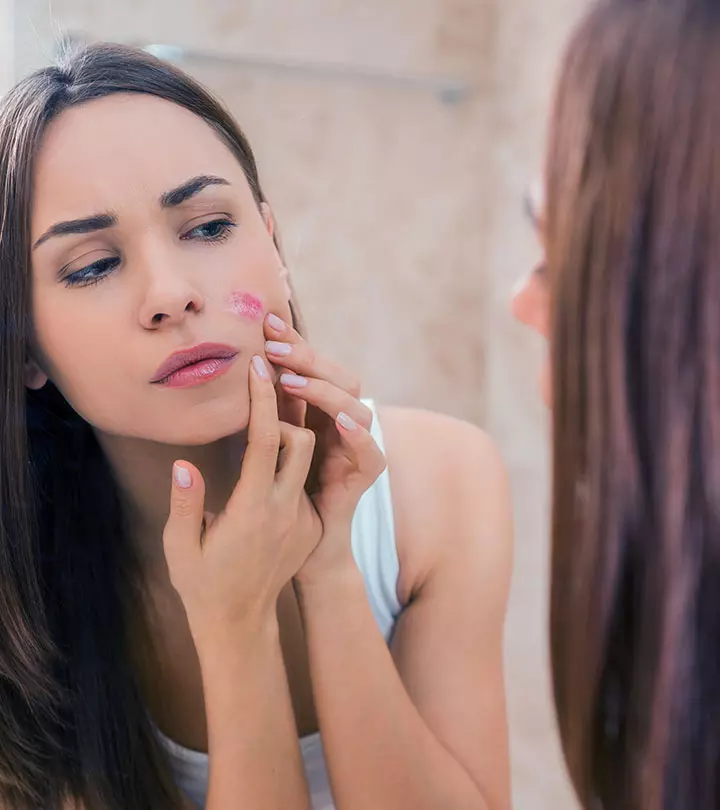
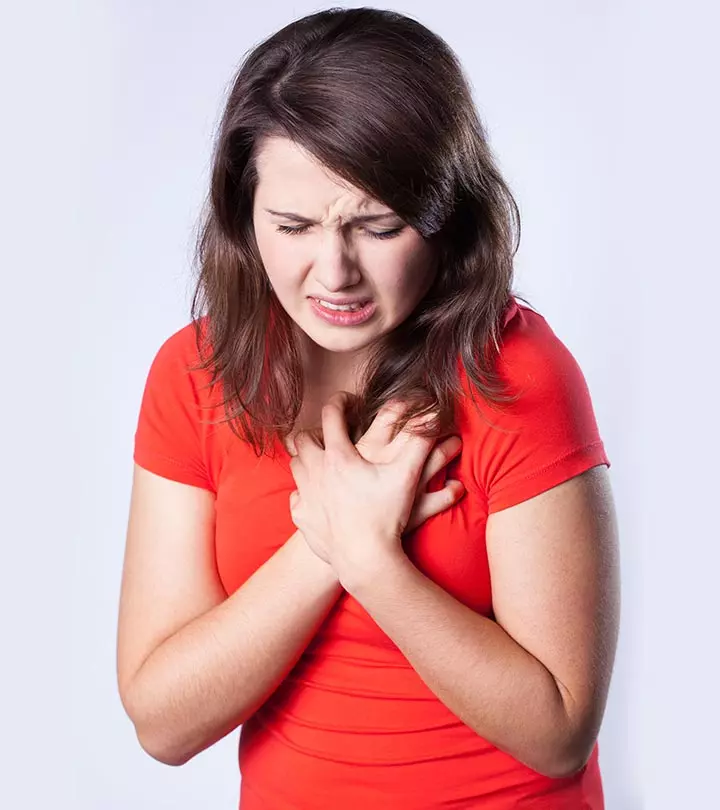
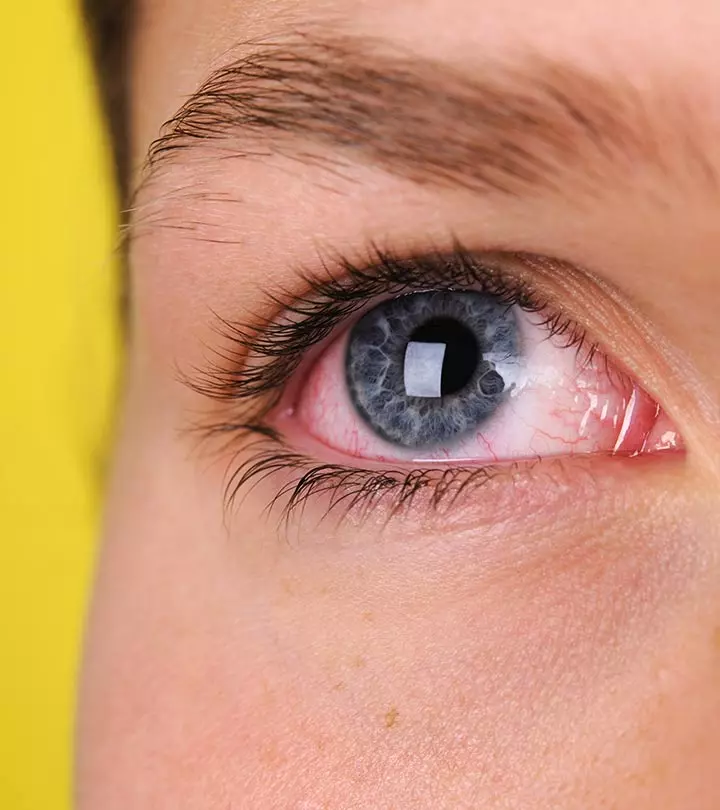
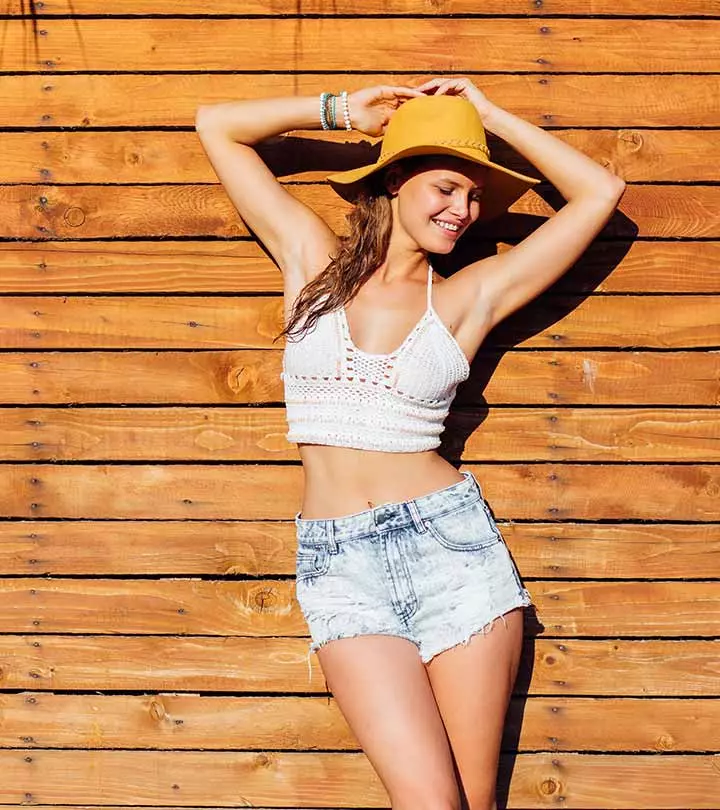
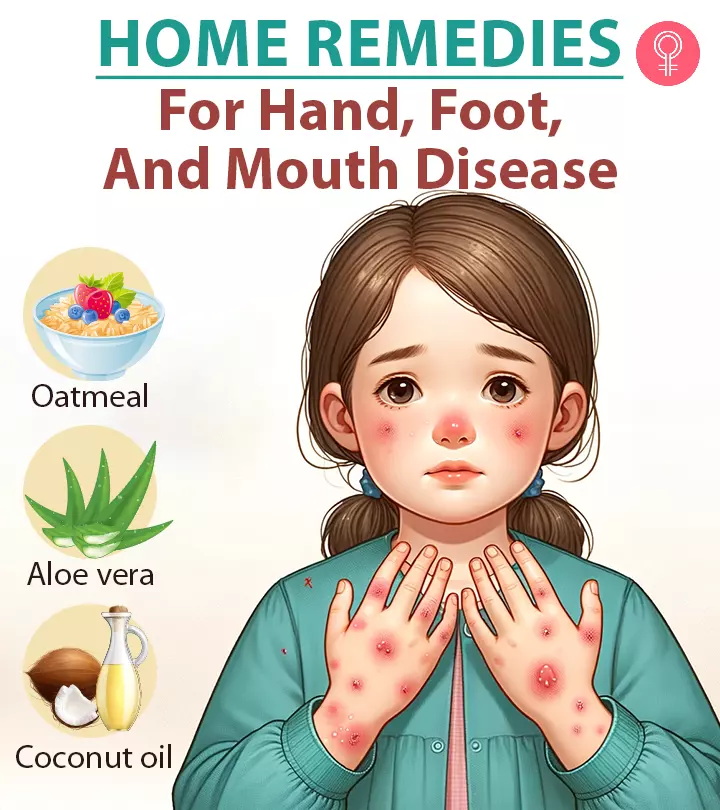
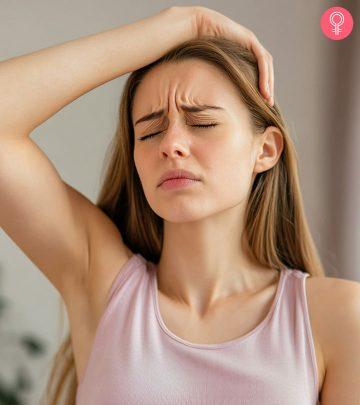

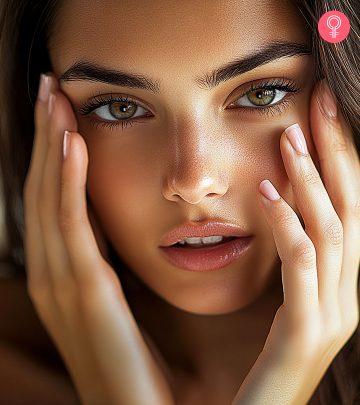
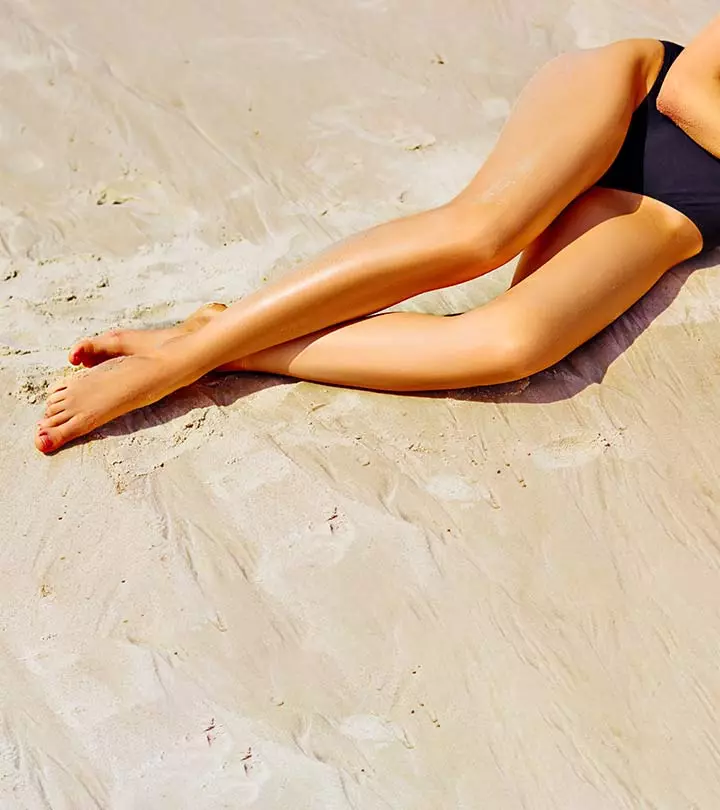
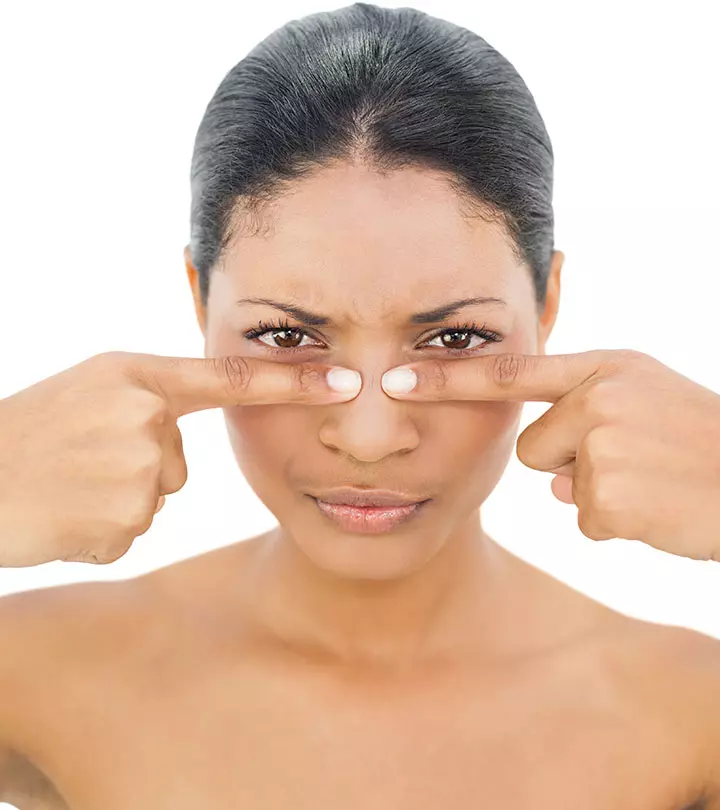
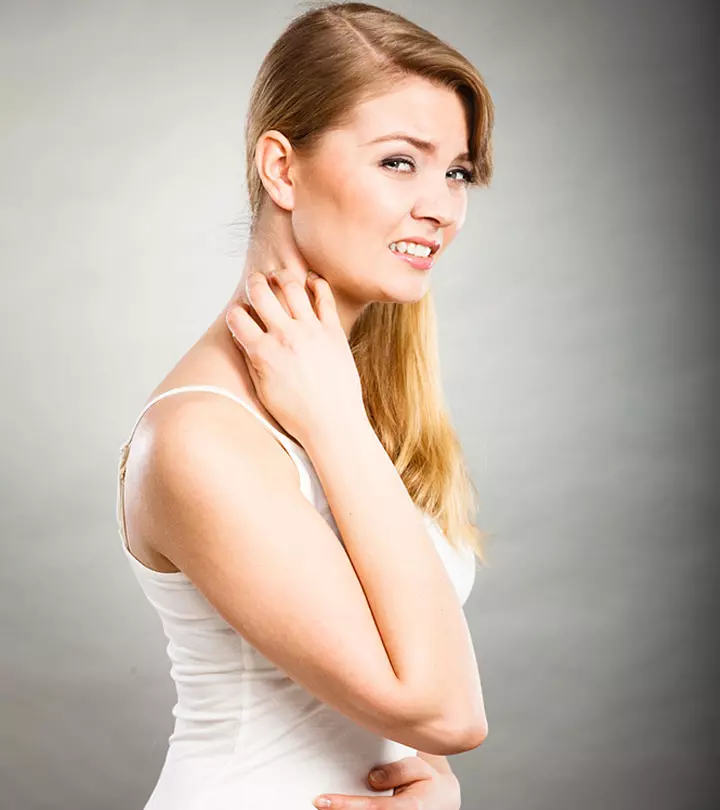

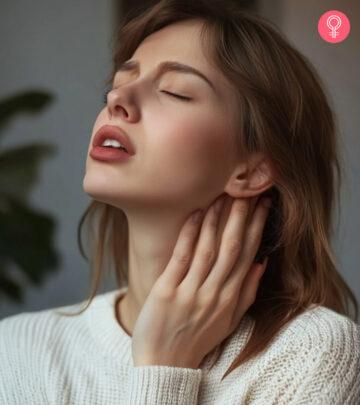
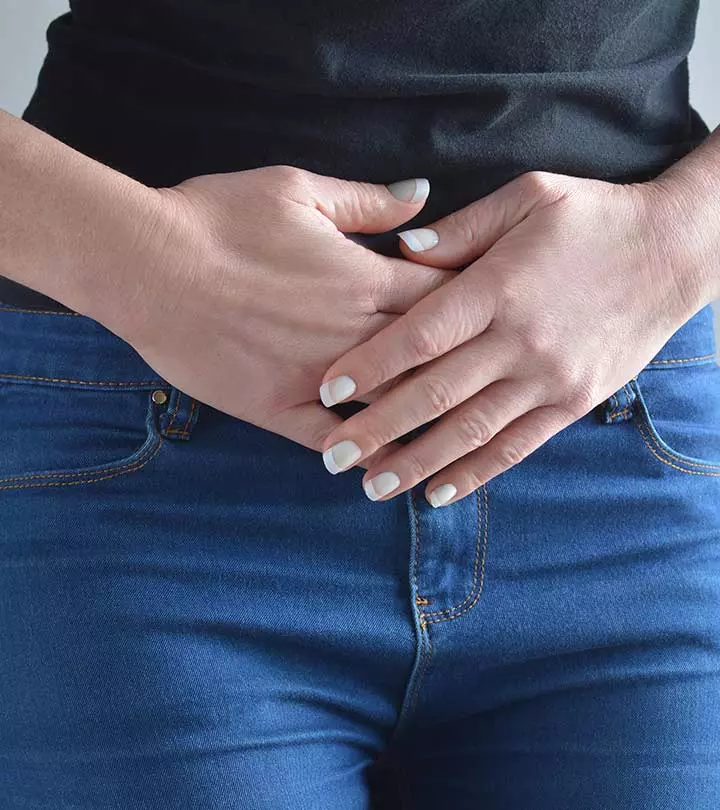
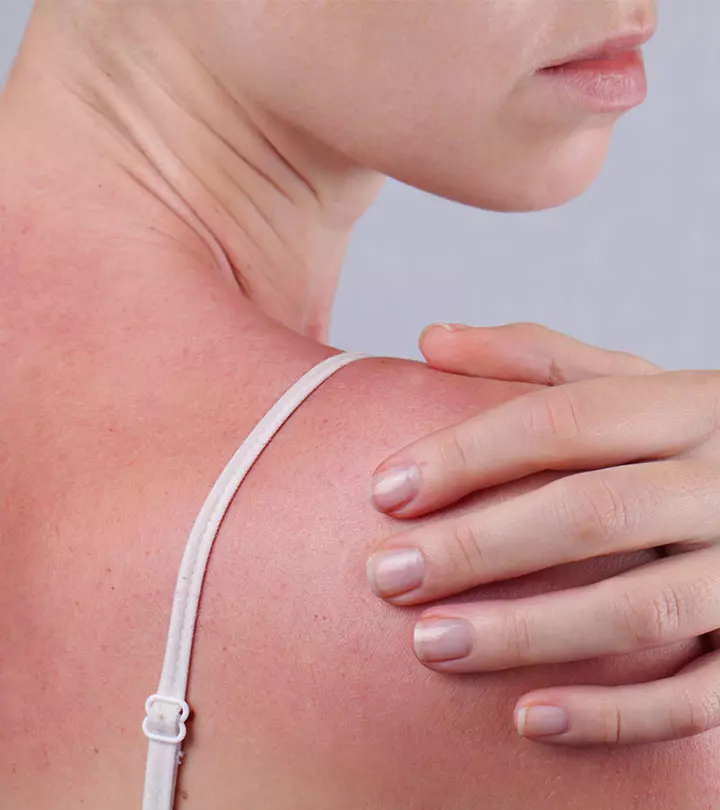
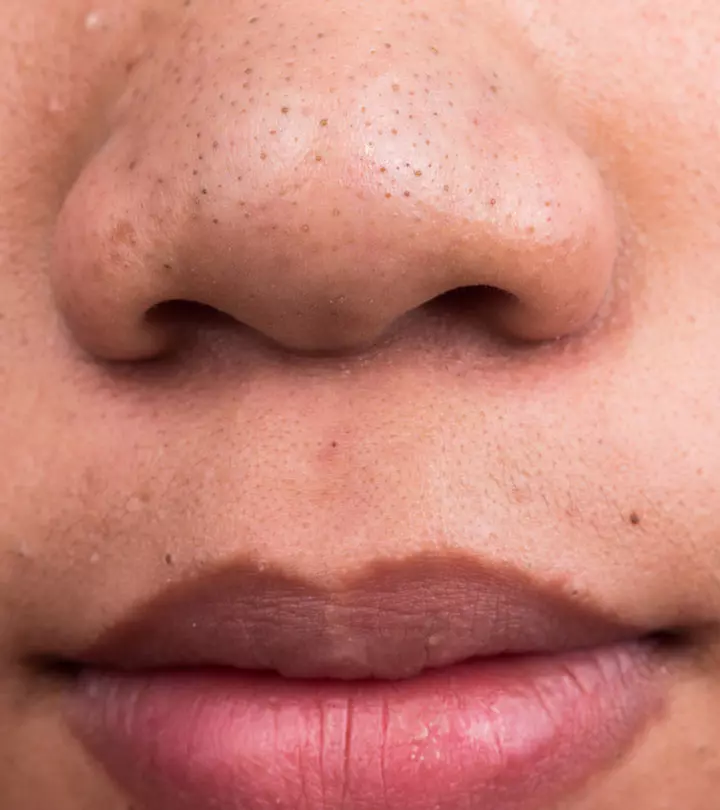
Community Experiences
Join the conversation and become a part of our empowering community! Share your stories, experiences, and insights to connect with other beauty, lifestyle, and health enthusiasts.